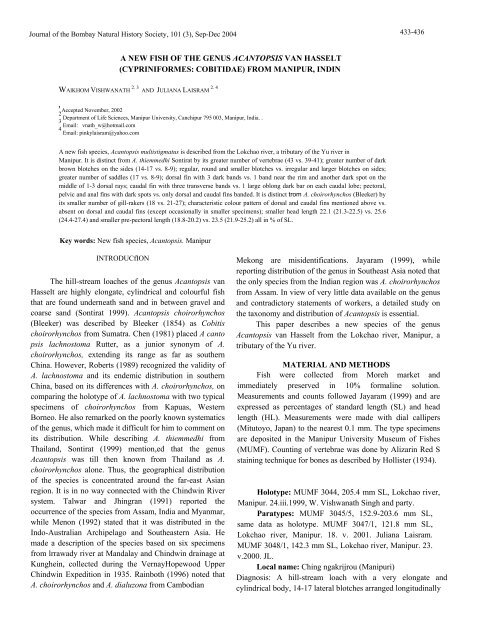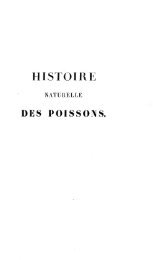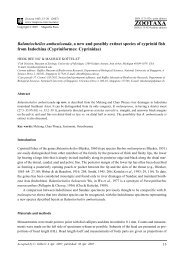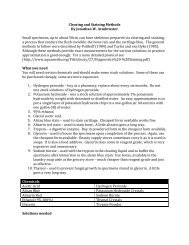A NEW FISH OF THE GENUS ACANTOPSIS VAN HASSELT ...
A NEW FISH OF THE GENUS ACANTOPSIS VAN HASSELT ...
A NEW FISH OF THE GENUS ACANTOPSIS VAN HASSELT ...
You also want an ePaper? Increase the reach of your titles
YUMPU automatically turns print PDFs into web optimized ePapers that Google loves.
Journal of the Bombay Natural History Society, 101 (3), Sep-Dec 2004<br />
A <strong>NEW</strong> <strong>FISH</strong> <strong>OF</strong> <strong>THE</strong> <strong>GENUS</strong> <strong>ACANTOPSIS</strong> <strong>VAN</strong> <strong>HASSELT</strong><br />
(CYPRINIFORMES: COBITIDAE) FROM MANIPUR, INDIN<br />
WAlKHOM VISHWANATH 2. 3 2. 4<br />
AND JULIANA LAISRAM<br />
' Accepted November, 2002<br />
2 Department of Life Sciences, Manipur University, Canchipur 795 003, Manipur, India. .<br />
3 Email: vnath_w@hotmail.com<br />
4 Email: pinkylaisram@yahoo.com<br />
A new fish species, Acantopsis multistigmatus is described from the Lokchao river, a tributary of the Yu river in<br />
Manipur. It is distinct from A. thiemmedhi Sontirat by its greater number of vertebrae (43 vs. 39-41); greater number of dark<br />
brown blotches on the sides (14-17 vs. 8-9); regular, round and smaller blotches vs. irregular and larger blotches on sides;<br />
greater number of saddles (17 vs. 8-9); dorsal fin with 3 dark bands vs. 1 band near the rim and another dark spot on the<br />
middle of 1-3 dorsal rays; caudal fin with three transverse bands vs. 1 large oblong dark bar on each caudal lobe; pectoral,<br />
pelvic and anal fins with dark spots vs. only dorsal and caudal fins banded. It is distinct trom A. choirorhynchos (Bleeker) by<br />
its smaller number of gill-rakers (18 vs. 21-27); characteristic colour pattern of dorsal and caudal fins mentioned above vs.<br />
absent on dorsal and caudal fins (except occasionally in smaller specimens); smaller head length 22.1 (21.3-22.5) vs. 25.6<br />
(24.4-27.4) and smaller pre-pectoral length (18.8-20.2) vs. 23.5 (21.9-25.2) all in % of SL.<br />
Key words: New fish species, Acantopsis. Manipur<br />
INTRODUCfION<br />
The hill-stream loaches of the genus Acantopsis van<br />
Hasselt are highly elongate, cylindrical and colourful fish<br />
that are found underneath sand and in between gravel and<br />
coarse sand (Sontirat 1999). Acantopsis choirorhynchos<br />
(Bleeker) was described by Bleeker (1854) as Cobitis<br />
choirorhynchos from Sumatra. Chen (1981) placed A canto<br />
psis lachnostoma Rutter, as a junior synonym of A.<br />
choirorhynchos, extending its range as far as southern<br />
China. However, Roberts (1989) recognized the validity of<br />
A. lachnostoma and its endemic distribution in southern<br />
China, based on its differences with A. choirorhynchos, on<br />
comparing the holotype of A. lachnostoma with two typical<br />
specimens of choirorhynchos from Kapuas, Western<br />
Borneo. He also remarked on the poorly known systematics<br />
of the genus, which made it difficult for him to comment on<br />
its distribution. While describing A. thiemmedhi from<br />
Thailand, Sontirat (1999) mention,ed that the genus<br />
Acantopsis was till then known from Thailand as A.<br />
choirorhynchos alone. Thus, the geographical distribution<br />
of the species is concentrated around the far-east Asian<br />
region. It is in no way connected with the Chindwin River<br />
system. Talwar and Jhingran (1991) reported the<br />
occurrence of the species from Assam, India and Myanmar,<br />
while Menon (1992) stated that it was distributed in the<br />
Indo-Australian Archipelago and Southeastern Asia. He<br />
made a description of the species based on six specimens<br />
from lrrawady river at Mandalay and Chindwin drainage at<br />
Kunghein, collected during the VernayHopewood Upper<br />
Chindwin Expedition in 1935. Rainboth (1996) noted that<br />
A. choirorhynchos and A. dialuzona from Cambodian<br />
433-436<br />
Mekong are misidentifications. Jayaram (1999), while<br />
reporting distribution of the genus in Southeast Asia noted that<br />
the only species from the Indian region was A. choirorhynchos<br />
from Assam. In view of very little data available on the genus<br />
and contradictory statements of workers, a detailed study on<br />
the taxonomy and distribution of Acantopsis is essential.<br />
This paper describes a new species of the genus<br />
Acantopsis van Hasselt from the Lokchao river, Manipur, a<br />
tributary of the Yu river.<br />
MATERIAL AND METHODS<br />
Fish were collected from Moreh market and<br />
immediately preserved in 10% formaline solution.<br />
Measurements and counts followed Jayaram (1999) and are<br />
expressed as percentages of standard length (SL) and head<br />
length (HL). Measurements were made with dial callipers<br />
(Mitutoyo, Japan) to the nearest 0.1 mm. The type specimens<br />
are deposited in the Manipur University Museum of Fishes<br />
(MUMF). Counting of vertebrae was done by Alizarin Red S<br />
staining technique for bones as described by Hollister (1934).<br />
Holotype: MUMF 3044, 205.4 mm SL, Lokchao river,<br />
Manipur. 24.iii.1999, W. Vishwanath Singh and party.<br />
Paratypes: MUMF 3045/5, 152.9-203.6 mm SL,<br />
same data as holotype. MUMF 3047/1, 121.8 mm SL,<br />
Lokchao river, Manipur. 18. v. 2001. Juliana Laisram.<br />
MUMF 3048/1, 142.3 mm SL, Lokchao river, Manipur. 23.<br />
v.2000. JL.<br />
Local name: Ching ngakrijrou (Manipuri)<br />
Diagnosis: A hill-stream loach with a very elongate and<br />
cylindrical body, 14-17 lateral blotches arranged longitudinally
<strong>NEW</strong> DESCRIPTIONS<br />
Fig. 1: Lateral view of Acantopsis multistigmatus sp. novo<br />
on the flanks and 17 dark brown saddles across the back, a<br />
pattern of many small, transverse and horizontal wavy bars<br />
and spots arranged longitudinally between the saddles and<br />
the blotches. Three rows of dark brown spots on dorsal fin<br />
and two on pelvic fm. No black spot at the upper base of<br />
caudal fin. Pectoral, pelvic and anal fins spotted with black.<br />
Caudal fin slightly emarginated. Gill-rakers 18 (4+ 14).<br />
Description: D. iii, 9112; P. i, 9-10; V. i, 6;A. iii, 5; C.<br />
7+7.<br />
Body very elongate and compressed, its depth 10.9<br />
(9.7-12.0), head long, 21. 9 (21.3-22.4), longer than caudal<br />
length which is 15.9 (13.8-17.4) all in % SL. Snout much<br />
elongated, 68.3 (65.4-70.6)% HL and pointed. Eyes small,<br />
subcutaneous, situated dorsally very close to the occiput, its<br />
diameter longer than inter-orbital width. An erectile bifid<br />
spine present between the nostrils and orbit, nearer to the<br />
riostrils, level with the lower margin of the orbit. Mouth<br />
small, inferior. Barbels four pairs, two rostral and two<br />
maxillary, all small. Lips thick, both fringed, mental lobes<br />
well developed into two fringed prolongations. Gill<br />
openings small, extending only a little above origin of<br />
pectorals.<br />
Characters<br />
Gill-rakers<br />
Colour<br />
Vertebrae<br />
Caudal fin<br />
Max. SL<br />
Distribution<br />
434<br />
Caudal peduncle long, its least depth 2.6 (2.4-2.8) in its<br />
length. Scales minute, absent on head. Lateral line complete.<br />
Dorsal fin origin midway between tip of snout and caudal fin base,<br />
slightly in advance of ventral fin origin. Anal fin short, caudal fin<br />
slightly emarginate, the lower lobe longer. Ventral fin nearer<br />
caudal fin base than ti}1 of snout (Fig. 1).<br />
Colour: Creamy yellow with 14-17 lateral blotches<br />
arranged longitudinally on flanks and 17 saddles across back;<br />
pattern of many small, transverse and horizontal wavy bars and<br />
spots arranged longitudinally between the saddles and the<br />
blotches, all in dark brown tints. Three rows of dark brown spots<br />
on dorsal fin, two on pelvic fin. Pectoral, pelvic and anal fins<br />
spotted with black. The pattern on the body is also found on the<br />
head.<br />
Distribution: INDIA: Lokchao river, Manipur, Assam..<br />
Myanmar.<br />
Etymology: The species is named after the large number of<br />
deep dark brown blotches on the sides.<br />
Remarks: Acantopsis multistigmatus sp. nov. is<br />
distinguished from A. choirorhynchos in having fewer gill-<br />
Table 1: Morphometry and distribution of A. multistigmatus sp. nov., A. thiemmedhi and A. choirorhynchos<br />
Acantopsis multistigmatus sp. nov<br />
18<br />
14-17 blotches, 17 saddles on dorsal part of<br />
body. 3 rows of black spots on dorsal and 2<br />
rows on caudal fins. Pectoral, pelvic and<br />
anal fins spotted with rows of dark spots.<br />
43<br />
Slightly emarginated<br />
181 mm<br />
Lokchao river, Manipur, India<br />
A. thiemmedhi Sontirat<br />
16-18<br />
8-9 irregular blotches, 8-9 saddles on<br />
dorsal part of body.<br />
1 row and a blotch at 1st three dorsal rays.<br />
1 large oblong dark bar near the middle<br />
part of each caudal lobe. Only dorsal and<br />
caudal fins banded, other fins hyaline<br />
39-41<br />
Bilobed<br />
132 mm<br />
Thailand<br />
A. choirorhynchos Sontirat 1999<br />
21-27<br />
No markings on caudal and dorsal fins.<br />
However, small dark lateral spots and<br />
blotches on sides and back and three<br />
rows of small dark spots on dorsal<br />
mayor may not be present in small<br />
specimens.<br />
40-44<br />
-<br />
-<br />
India: Assam, Borneo, Java, Malaya,<br />
Myanmar, Sumatra, Thailand, Vietnam.<br />
(Jayaram 1999)
<strong>NEW</strong> DESCRIPTIONS<br />
Table 2: Morphometric comparison of A. mu/tistigmatus sp. novo with A. thiemmedhi and A. choirorhynchos<br />
Holotype MUMF 3044<br />
A. mu/tistigmatus sp. novo<br />
Paratype (N=7) MUMF 3045/5,<br />
3047/1, 3048/1<br />
Mean (Range)<br />
Standard Length 181.0 . 103.2-181.0<br />
A. thiemmedhi<br />
Sontirat (1999)<br />
Mean (Range)<br />
A. choirorhynchus<br />
Sontirat (1999)<br />
Mean (Range)<br />
Body Depth 9.9 10.6(9.7-12.0) 13.5(12.3-15.2) 11.8(9.8-13.0)<br />
Caudal Length 16.2 15.1(13.8-17.4) - -<br />
Head Length 22.0 22.1 (21.3-22.3) 24.9(23.4-26.1) 25.6(24.4-27.4)<br />
Height of head (occiput) 8.7 9.4(8.7-10.4)<br />
Height of head (eye) 8.6 8.9(8.3-9.8)<br />
Snout Length 15.5 15.0(14.3-15.5)<br />
Eye Diameter 2.2 2.4(2.2-2.6)<br />
Inter-orbital space 1.3 1.8(1.3-2.0)<br />
Inter-narial space - 1.5(0.8-1.6)<br />
Gape width 1.8 2.2(1.7-2.4)<br />
Length of caudal peduncle 12.3 12.2(11.6-12.3)<br />
Height of caudal peduncle 4.5 4.7(4.5-5.0)<br />
Pre-dorsal length 48.9 48.9(47.8-50.0)<br />
Post-dorsallength 50.1 49.9(49.6-50.1)<br />
Pre-pectoral length 18.8 19.5(18.8-20.2) 22.4(20.4-27.8) 23.5(21.9-25.2)<br />
Pre-pelvic length 50.4 53.7(50.4-55.0) 56.3(54.1-58.5) 57.8(54.5-59.2)<br />
Pre-anal length 75.9 79.7(75.9-81.3) 79.9(78.8-83.4) 81.2(72.2-86.6)<br />
Pre-anus length 71.6 78.4(71.6-103.6)<br />
Max. head-width 6.5 7.4(5.7-8.1)<br />
Head width (nares) 3.7 4.4(3.6-4.9)<br />
Body width at dorsal origin 8.6 9.4(7.5-10.1)<br />
Body width at anal origin 5.1 6.3(5.1-6.8)<br />
Dorsal fin base length 11.0 12.4(11.0-13.0) 14.3(14.2-15.4) 14.4(12.7-16.1)<br />
Dorsal fin height 11.2 12.5(11.2-13.0) - -<br />
Anal fin base length 7.4 7.8(7.1-8.7) 7.9(5.5-10.5) 8.1 (6.0-9.6)<br />
Pectoral fin length 13.7 14.1(13.6-15.5) 16.7(14.3-20.5) 13.5(10.8-15.6)<br />
Pelvic fin length 10.2 11.0(10.2-11.3) 9.5(8.5-14.5) 9.3(7.6-11.1)<br />
rakers [18 vs. 21-27], shorter head length [22.0 (21.3-22.4) vs. 25.6<br />
(24.4-27.4)% SL], shorter pre-pectoral length [19.5 (18.820.2) vs.<br />
23.5 (21.9-25.2) %SL]. Sontirat (1999) examined as many as 180<br />
specimens of A. choirorhynchos and found no dark blotches or spots<br />
on caudal and dorsal fins in larger specimens. However, the smaller<br />
specimens had small dark lateral spots and/or blotches on the sides<br />
and back, and some of these had three rows of small dark spots on the<br />
dorsal fin. The new species is also distinct from A. choirorhynchos, as<br />
described by Roberts (1989) by its longer head [head length 4.5-4.7<br />
vs. 3.8 %SL], shallower caudal peduncle [caudal peduncle depth 19.9-<br />
22.4 vs. 22.3-23.0 %SL], greater numbers of vertebrae [43 vs. 42] and<br />
fewer dorsal fin rays [iii, 9½ vs. iii,10½]. The new species also differs<br />
from A. choirorhynchos, as described by Day (1878) in its<br />
shallower body [body depth 9.3 (8.5-10.4) vs. 11.1 %TL], shorter<br />
head [19.2 (18.9-19.6) vs. 20.0 % TL] and caudal fin [caudal length<br />
13.3 (12.1-14.7) vs. 16.7 %TL]; in having more blotches on sides of<br />
body [14-17 vs. 12], more saddles across the back [17 vs. 12], and<br />
more rows of blotches along dorsal fin [3 vs. 2]. The new species<br />
J. Bombay Nat. Hist. Soc., 101 (3), Sep-Dec 2004<br />
Table 3: Comparison of Acantopsis mu/tistigmatus sp. novo<br />
with A. choirorhynchos Day (1878)<br />
Characters A. mu/tistigmatus sp. nov. A. choirorhynchos Day<br />
Body depth<br />
(% of TL)<br />
9.3(8.5-10.4) 11.1<br />
Caudal length<br />
(% of TL)<br />
Head length<br />
(% of TL)<br />
Number of<br />
blotches at<br />
sides<br />
Number of<br />
bands across<br />
back<br />
Number of<br />
bands along<br />
dorsal<br />
Number of<br />
bands<br />
across anal<br />
Fin counts<br />
13.3(12.1-14.7) 16.7<br />
19.2(18.9-19.6) 20.0<br />
14-17 12<br />
17 12<br />
3 2<br />
Few irregular spots 3 rows of blotches<br />
D. iii, 9Y2; P. i, 9-10; V. i,6;<br />
A. iii, 5Y2; C. 7+7<br />
D. iii, 9; P. 11; V. 7;<br />
A. iii, 5; C. 11<br />
435
<strong>NEW</strong> DESCRIPTIONS<br />
has a few irregularly arranged spots across the anal fin, in<br />
contrast with the three rows of blotches in A.<br />
choirorhynchos. (The comparison is given in Table 3).<br />
A. multistigmatus sp. nov. can be distinguished from<br />
A. thiemmedhi Sontirat by the colour pattern, 14-17<br />
blotches vs. 8-9 irregular blotches on the lateral line, 17 vS.<br />
8-9 saddles on the dorsal part of the body; a pattern of<br />
many small, transverse and horizontal wavy bars and spots<br />
arranged longitudinally up to the caudal peduncle region<br />
between the saddles and the blotches vs. only a row of<br />
broken horizontal<br />
wavy bars up to the posterior region of dorsal fin; 3 rows of<br />
black spots each on dorsal and caudal fins vs. 1 row and a<br />
blotch at first three dorsal rays and one large oblong dark<br />
bar near the middle part of each caudal lobe; body depth<br />
10.9 (9.7-12.0) vS. 13.5 (12.3-15.2), pre-pectoral length<br />
19.5 (18.820.2) vS. 22.4 (20.4-27.8), dorsal base length<br />
12.3 (11.0-13.0) vs. 14.3 (14.2-15.4) all in %ofSL, head<br />
depth 42.9 (39.7-46.3) vS. 58 (53.0-59.5), eye diameter<br />
10.7 (10.1-11.7) vS. 14.9 (13.7-16.6) and snout length 68.0<br />
(65.4-70.6) vS. 62.4 (57.9-64.1) all in % of head length.<br />
The new species also differs from A. thiemmedhi in its<br />
slightly emarginate caudal fin, as compared to bilobed one<br />
of the latter, larger size (103.2181.0 mm vs. 46.7-122.8<br />
mm) SL. (Comparisons are given in Tables 1 and 2). The<br />
percentage measurement of head depth, eye diameter and<br />
snout length provided by Sontirat (1999) is in percentage of<br />
head length and not in percentage of standard length as is<br />
printed.<br />
REFERENCES<br />
A. multistigmatus is also distinct from A. lachnostoma<br />
Rutter in its caudal peduncle depth 4.7 (4.5-5.0) vS. 7.6 % 5<br />
dorsal fin rays iii, 9½ vs. iii, 7½ and number of vertebrae 43 .<br />
44.<br />
Talwar and Jhingran (1991), Menon (1992) and<br />
Jayaram (1999) reported A. choirorhynchos to be widely<br />
distributed the South-eastern Asian region. However, its<br />
distribution outside Borneo, Sumatra and Thailand<br />
region nee confirmation, as the description of the species<br />
from Thailand given by Sontirat (1999) does not fit into<br />
the description gi\l by them. Three species of this genus<br />
from the Mekong ha been reported as misidentified by<br />
Rainboth (1996) and are being kept as sp. 1, sp. 2 and sp.<br />
3. The identity of A. choirorhynchos requires<br />
confirmation in view of comment by Roberts (1989) that<br />
due to the paucity of systematic knowledge of this genus,<br />
statements on species distributions are not meaningful.<br />
As the drainage in which the hitherto known A.<br />
choirorhynchos of the Indian region totally different<br />
from the type locality of the species, care examination of<br />
the specimens is required for their correct identification.<br />
ACKNOWLEDGEMENT<br />
The first author is grateful to ICAR-NATP Project<br />
Germplasm Inventory and Gene-Banking of Freshwater<br />
Fish for financial assistance.<br />
BLEEKER, P. (1854): Overzicht der ichthyologische fauna van Sumatra, Pisces Vol. iv. Teleostei - Cobitoidea, part 2 Cobitidae. Zoolog<br />
met beschrijving van eenige nieuwe sorten. Nat. Tijdschr. Nederl. Survey of India, Kolkata. 113 pp, 10 pis.<br />
Indie 7: 49-108.<br />
RAINBOTH, W.J. (1996): Fishes of the Cambodian Mekong. Food:<br />
CHEN, J. (1981): A study on the classification of the subfamily Cobitinae<br />
Agriculture Organization, Rome. 265 pp. 27 pis.<br />
of China. Trans. Chin. Ichthyol. Soc. I: 21-31.<br />
ROBERTS, T.R. (1989): The freshwater fishes of Western Bon<br />
DAY, F. (1878): The Fishes ofIndia; being a natural history of the fishes<br />
(Kalimantan Barat, Indonesia). Mem. Calif. A cad. Sci. 14: 2<br />
known to inhabit the seas and fTeshwaters of India, Burma and SONTIRAT, S. (1999): Description of a new species of AcantoJ<br />
Ceylon. Text and Atlas in 4 parts. London: xx + 778, pis.<br />
(Cypriniformes: Cobitidae) from Thailand. Proc. 5th Indo-!<br />
HOLLISTER, G. (1934): Clearing and dyeing fish for bone study. Zoologica Fish Conf, Noumea. Seret B. & J.-Y. Sire, eds. Paris: oS Fr.<br />
12: 89-101.<br />
Ichthyol., 65-68.<br />
JAYARAM, K.C. (1999): The freshwater fishes of the Indian region.<br />
TALWAR, P.K. & A.G. JHINGRAN (1991): Inland Fishes of India:<br />
Narendra Publishing House, New Delhi. 551 pp.<br />
Adjacent Countries. Vol. 1. Oxford and IBH Publ., New De pp.<br />
MENON, A.G.K. (1992): The fauna of India and the adjacent countries.<br />
541.<br />
. . .<br />
436 J. Bombay Nat. Hist. Soc., 101 (3), Sep-Dec 21





